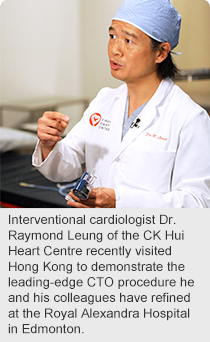
October 2, 2014
Story by Gregory Kennedy; photo by Dale Macmillan
No stranger to plugged pipelines and a steamfitter by trade, oilsands worker Glen Nichols knew he was in big trouble when a heart attack jolted him from a dead sleep in Fort McMurray last winter.
After a swift airlift to Edmonton and the clearing of one blocked artery at the Mazankowski Alberta Heart Institute, which restored some blood flow, he was left with an even more pressing dilemma — a second blockage that could not be cleared by traditional angioplasty — which usually means major bypass surgery.
When Nichols heard that heart patients with stubborn artery blockages that cannot be cleared by traditional angioplasty can now avoid bypass surgery thanks to a technique first brought to Western Canada by Alberta Health Services – specifically the CK Hui Heart Centre at the Royal Alexandra Hospital – he jumped at the opportunity.
 “It was put to me like this: I could either have my chest opened or I could try something new that works and is far less invasive,” says the 46-year-old construction coordinator. “The choice was pretty clear.”
“It was put to me like this: I could either have my chest opened or I could try something new that works and is far less invasive,” says the 46-year-old construction coordinator. “The choice was pretty clear.”
With the support of the Royal Alexandra Hospital Foundation, the Chronic Total Occlusion (CTO) program employs a leading-edge procedure to clear heart arteries via ‘back-door’ (or retrograde) angioplasty.
“It’s a whole different option of how we can open up these arteries,” says Dr. Raymond Leung, interventional cardiologist at the CK Hui. “As well, like tunnel builders, if need be, we can insert two catheters, one in each wrist, to meet in the middle, to work at the blockage from both sides.”
During a conventional angioplasty procedure, a thin wire is inserted into the groin (femoral artery) or wrist (radial artery) and threaded through the circulatory system to the blockage near the heart, where a balloon may be inflated to clear the vessel. Afterwards, a stent — a tiny wire mesh tube — can be inserted and left at the site to keep the artery open, improving blood flow.
Unlike conventional angioplasty, the retrograde CTO method threads a wire along a different route, often through tinier blood vessels, which lets doctors approach the back side of the arterial obstruction — opposite to the side facing blood flow, which can develop a hard “cap” from the blood pressure — to get rid of the obstruction from its softer side.
The CK Hui Heart Centre has gained a global reputation for its growing expertise and refinements to this procedure. Patients go home within hours as opposed to having major surgery, such as a heart bypass, which requires a minimum five-day hospital stay.
“A lot of patients who would otherwise have to go for open-heart surgery to have their blood flow restored can now be helped with just a catheter through an artery,” says interventional cardiologist Dr. William Hui. “With open-heart surgery, they’re in hospital at least five to seven days, and left with a sternal wound that may take months to recover from.”
Nichols underwent a two-wrist CTO procedure following his heart attack.
“What impressed me was the high level of professionalism and communication while I was awake on the table,” he says. “Everybody knew what they were doing in that room. There was no second-guessing. They made that difficult procedure seem so effortless.”
Celebrating its fifth anniversary, the CTO program continues to increase access to this procedure. In a typical year, 2,000 angioplasties are performed at the CK Hui. The number of patients who require the rare ‘back-door’ angioplasty at the CK Hui has grown to 80 patients this past year from 20 patients in its first year.
Andrew Otway, President and CEO of the Royal Alexandra Hospital Foundation, says: “This program is just one of many examples of how the CK Hui Heart Centre is really advancing the science of cardiology. We’re thrilled that our ongoing support of the CK Hui Heart Centre has resulted in so many innovative treatments, cutting-edge technology and excellent patient care.”